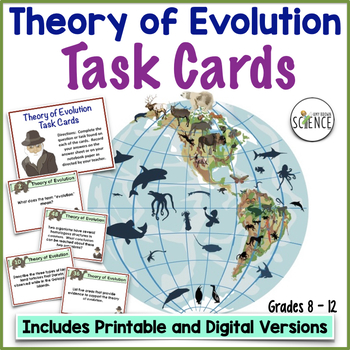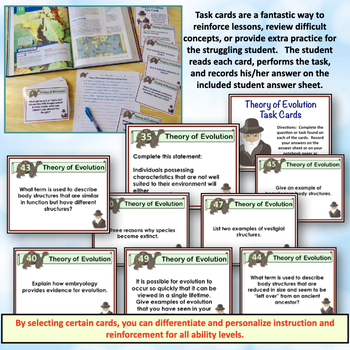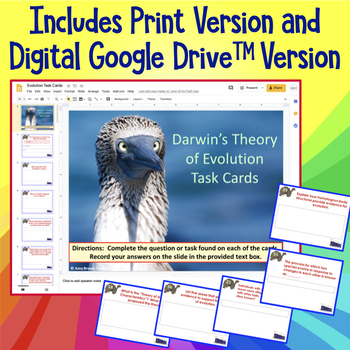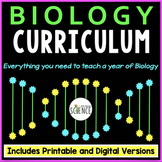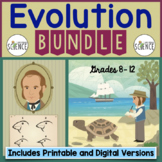Evolution Task Cards Activity - Natural Selection and Mechanisms of Evolution
- Zip
- Google Apps™
- Microsoft OneDrive

What educators are saying
Also included in
- This NO PREP, PRINTABLE, EDITABLE, AND DIGITAL Biology Curriculum contains everything you need for an entire year of Biology! For less than $3 a day, you can save your time, energy, and sanity. Each of the 20 Complete Units includes a teaching PowerPoint presentation, notes, labs, homework assignmenPrice $525.00Original Price $988.18Save $463.18
- This Theory of Evolution Complete Unit Bundle covers the work of Darwin, natural selection, the mechanisms of evolution, homology and homologous structures, embryology, patterns of evolution, and more. See complete list of topics below.This unit bundle includes everything you need to teach an introdPrice $31.95Original Price $40.73Save $8.78
Description
In this set of 57 task cards, students will answer questions about the life and travels of Charles Darwin and the events that led him to develop his theory of evolution. Printable and digital versions are included. Students will use their critical thinking skills to explain the evidence for evolution, and to give examples of the different patterns of evolution. Students will explore natural selection, artificial selection, the controversies surrounding Darwin's theory, and so much more.
Choose to use the traditional printable version, or the paperless, digital Google Apps version. This resource is perfect for distance learning and for students in 1:1 classrooms.
Click this link to view all of my Digital Resources.
Suitable for life science and biology students in grades 8 -12.
What is included in this resource?
- A set of 57 printable and editable task cards.
- Paperless Digital Version (not editable) for use in Google Drive, Google Classroom, and/or Microsoft OneDrive.
- A student answer sheet for recording answers.
- Blank task cards so that you can add additional questions.
- A complete teacher answer key.
- Teacher Guide containing tips, tricks, and suggestions for use.
- Review PowerPoint of 58 slides that can be used to go over answers with the students.
- Teacher guide to Google Apps
Task cards are a fantastic way to enrich or reinforce lessons, review difficult concepts, or provide extra practice for the struggling student. The student reads each card, performs the task, and records his/her answer on the included student answer sheet.
From the moment of purchase, you will be ready to use your task cards in just a few minutes. Simply print the sheets of task cards on card stock paper, laminate, and cut the cards apart. The cards look best when printed in color, but they can easily be printed in black and white.
This set of 57 task cards on evolution covers the following concepts and topics:
I. Introduction to Evolutionary Theory
• Biological Diversity
• What is a Theory?
• What is Evolution?
• Who “Discovered” Evolution?
II. Charles Darwin: A Brief Biography
III. The Voyage of the HMS Beagle
IV. Darwin’s Observations
• Enormous Number of Species
• Patterns of Diversity
• Fossils
• The Galapagos Islands
V. Ideas in Darwin’s Time
• A Time of Discovery
• Conflicting Views of Darwin’s Work
• An Ancient and Changing Earth
• Georges Cuvier
• James Hutton
• Charles Lyell
• Jean-Baptiste Lamarck
• Thomas Malthus
VI. Darwin Develops His Theory of Evolution
• When Darwin Returned Home
• What Changed?
VII. Darwin’s Theory of Evolution
• Common Ancestry
• Darwin Presents His Evidence
• Descent With Modification
• Artificial Selection
VIII. Evolution by Natural Selection
• Concepts of Darwin’s theory
• What is Natural Selection?
• Common Descent
• The Controversy
IX. The Evidence for Evolution
• The Fossil Record
• Geographic Distribution
• Homology
• Embryology
• Biological Molecules
X. Evolution in Action
XI. Patterns of Evolution
• Selection Pressure
• Extinctions
• Adaptive Radiation
• Convergent Evolution
• Divergent Evolution
• Coevolution
• Punctuated Equilibrium
Related Products Include:
Darwin's Theory of Evolution PowerPoint and Notes
Theory of Evolution Homework and Study Guide
Darwin's Diary: The Tale of Evolution
Evolution Lab: Modeling Natural Selection
Evolution Quizzes: Set of 2 Quizzes
Evolution and Classification Warm Ups and Interactive Notebook Pages
A Hardy Weinberg Lab Simulation Activity
Lab: Making Coacervates Origin of Life Evolution Lab Activity
The History of Life on Earth PowerPoint and Notes
For updates about sales and new products, please follow my store:

